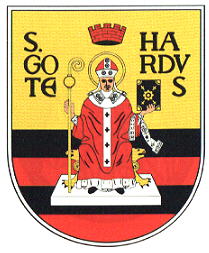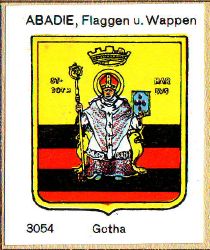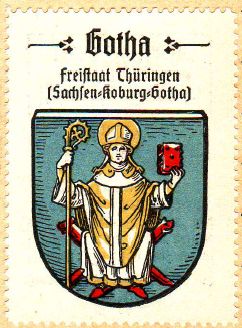Gotha: Difference between revisions
Knorrepoes (talk | contribs) m (Text replacement - "====Official blazon==== " to "====Official blazon==== (de) ") |
Knorrepoes (talk | contribs) m (Text replacement - "====Origin/meaning====" to "===Origin/meaning===") |
||
| Line 11: | Line 11: | ||
(de) Geteilt; das obere Feld in Gold, das untere dreimal geteilt von Schwarz und Rot; in Schildmitte ein nimbierter Bischof auf einem mit Greifenköpfen verzierten goldenen Sessel sitzend, in der Rechten den Krumm stab, in der Linken ein Buch haltend; über ihm schwebend eine fünftürmige rote Mauerkrone; auf der linken Seite die Buchstaben S. Goth, rechts HAR DVS (St. Gothardus). | (de) Geteilt; das obere Feld in Gold, das untere dreimal geteilt von Schwarz und Rot; in Schildmitte ein nimbierter Bischof auf einem mit Greifenköpfen verzierten goldenen Sessel sitzend, in der Rechten den Krumm stab, in der Linken ein Buch haltend; über ihm schwebend eine fünftürmige rote Mauerkrone; auf der linken Seite die Buchstaben S. Goth, rechts HAR DVS (St. Gothardus). | ||
===Origin/meaning=== | |||
The arms show St. Gothardus (961-1038), Bishop of Hildesheim. He already appears in the oldest known seal of the city, dating from 1250. Why the bishop is chosen is not clear, it may be as a canting symbol. There is no historical relation between the city and the bishop. | The arms show St. Gothardus (961-1038), Bishop of Hildesheim. He already appears in the oldest known seal of the city, dating from 1250. Why the bishop is chosen is not clear, it may be as a canting symbol. There is no historical relation between the city and the bishop. | ||
Revision as of 18:08, 22 June 2017
This page is part of the German heraldry portal |
Heraldry of the World |
|
German heraldry:
|
Selected collector's items from Germany:
|
GOTHA
State : Thüringen
District (Kreis) : Gotha
Additions : 1922 Siebleben; 1974 Sundhausen; 1994 Boilstädt, Uelleben
Official blazon
(de) Geteilt; das obere Feld in Gold, das untere dreimal geteilt von Schwarz und Rot; in Schildmitte ein nimbierter Bischof auf einem mit Greifenköpfen verzierten goldenen Sessel sitzend, in der Rechten den Krumm stab, in der Linken ein Buch haltend; über ihm schwebend eine fünftürmige rote Mauerkrone; auf der linken Seite die Buchstaben S. Goth, rechts HAR DVS (St. Gothardus).
Origin/meaning
The arms show St. Gothardus (961-1038), Bishop of Hildesheim. He already appears in the oldest known seal of the city, dating from 1250. Why the bishop is chosen is not clear, it may be as a canting symbol. There is no historical relation between the city and the bishop.
The basic composition has not changed since, but the shape of the saint and the other attributes has changed considerably during the centuries.
Hupp showed in the 1920s the arms in a more simplified version:
| The arms in the Abadie albums |
The arms by Hupp in the Kaffee Hag albums +/- 1925 |
Contact and Support
Partners:
Your logo here ?
Contact us
© since 1995, Heraldry of the World, Ralf Hartemink 
Index of the site
Literature : Hupp, O: Kaffee Hag albums, 1920s; Benzing et al, 1984; Ulle, 1997














